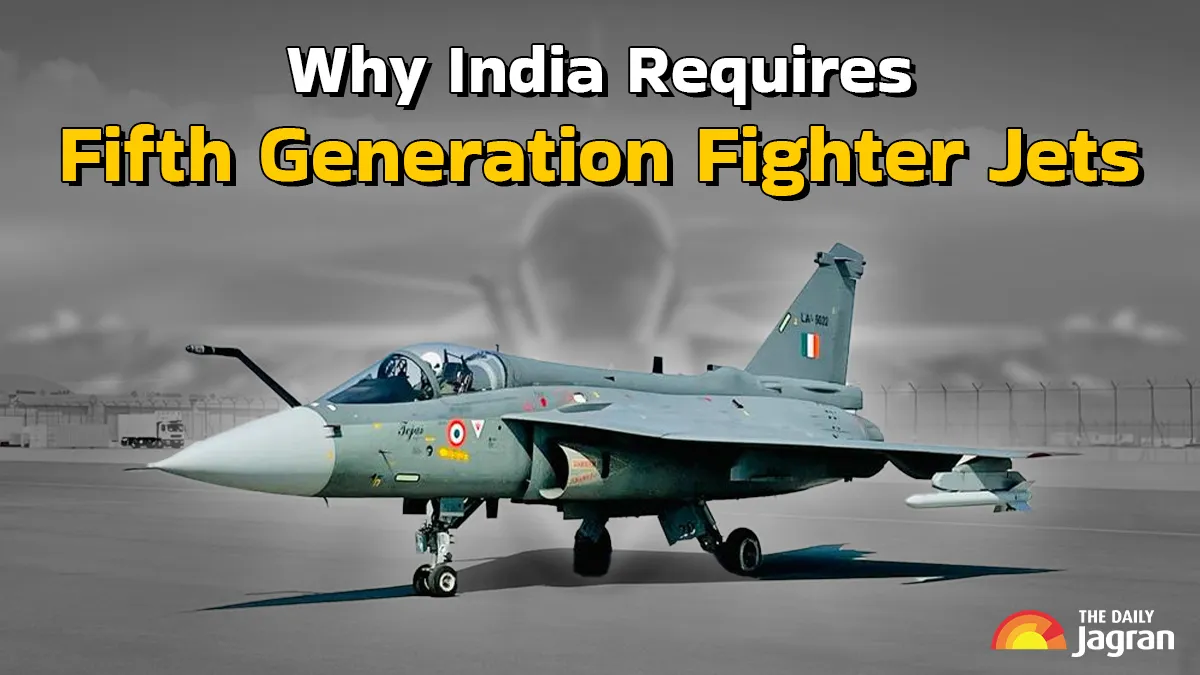- By Jeet Kumar
- Fri, 06 Jun 2025 09:09 PM (IST)
- Source:JND
Defence Minister Rajnath Singh earlier this week approved the manufacturing of India's indigenous fifth-generation stealth fighter jet. The Defence Research and Development Organisation (DRDO) is already working on the design of its model, the Advanced Medium Combat Aircraft (AMCA). Currently, only three countries, the United States, Russia, and China – possess fifth-generation stealth fighter jets.
Let's delve into what fifth-generation aircraft are and why it's crucial for India to have indigenous ones.
What Is AMCA
India's first fifth-generation fighter jet will be a single-seat, twin-engine aircraft. It will be equipped with advanced stealth coating and internal weapon bays. Weapons placed in these internal bays are not visible externally. This feature is also present in America's F-22 and Russia's Su-57 fighter jets. The AMCA will have two versions.
The first version will be powered by a GE-414 engine made in the United States. The second version will feature an indigenous jet engine, which will be more powerful than the GE-414. Overall, this will be a multi-role fighter jet with supermaneuverable and stealth features.
Expected Features: Can reach a maximum altitude of 55,000 feet; weapons in internal bay: 1,500 kilograms; external: 5,500 kilograms; fuel capacity: 6,500 kilograms.

Supermaneuverable
This refers to a fighter aircraft's ability to perform tactical movements, such as sudden changes in direction and attacking another fighter jet from various angles. Such manoeuvres are not possible with traditional aerodynamics technology.
Stealth
Aircraft, submarines or missiles equipped with stealth capabilities are not easily detected by radar or sonar systems.
Multirole
Multirole means that a fighter aircraft can carry out various types of tactical missions, such as achieving air superiority, conducting ground attacks and penetrating enemy territory to destroy their air defense systems.
In military terminology, this is called a SEAD (Suppression of Enemy Air Defences) operation. Fifth-generation fighter jets are the most advanced combat aircraft, equipped with stealth capabilities, supercruise and cutting-edge digital technologies.

Key Features
Stealth: The ability to evade radar detection, making it difficult for the enemy to spot the aircraft easily.
Supercruise: The ability to fly at supersonic speeds (above Mach 1) without using afterburners.
Sensor fusion: Integrating data from all sensors to provide the pilot with a complete picture of the battlefield.
Network-centric warfare: Sharing real-time data with other aircraft, drones, and command centers.
AI and automation: AI-based electronic piloting and automated target tracking.
Why India Needs Fifth Generation Aircraft
The People’s Liberation Army Air Force (PLAAF) has over 250 J-20 stealth jets. New jets like the J-35 are also being developed. The 2020 Ladakh standoff showed that China’s air force strength could pose a threat to India.
Pakistan plans to acquire J-35 fighter jets from China soon. In the recent Operation Sindoor, India demonstrated air superiority over Pakistan, but without stealth fighter jets, it will be difficult to maintain this advantage in the future.
Foreign Options
The United States has offered India the F-35 fighter jets, and Russia has offered its Su-57 fighter jets. India may choose any of these aircraft, but given the changing strategic landscape, it is essential for India to develop indigenous fighter jets.
The United States imposes various conditions along with its weapons and platforms. Meanwhile, Russia’s defence supply capacity has also been limited due to the war in Ukraine. In this context, India is making full efforts to achieve self-reliance in the defence sector.
Kaveri Project
The Kaveri engine is an indigenous turbojet engine of India. It is being developed by the Gas Turbine Research Establishment (GTRE) under DRDO. The project began in the late 1980s, with the primary goal of powering the indigenous Light Combat Aircraft (LCA) Tejas.
Key Step Toward Defense Self-Reliance
India’s ambitious project is a significant step toward making the country self-reliant in defence. The stealth UAV will be powered by this engine. Started in the 1980s, the project aimed to reduce India’s dependence on foreign engines for its fighter jets. However, after India’s 1998 nuclear tests, sanctions led to challenges like low thrust, weight issues, and delays.
In 2008, it was separated from the Tejas program, but now it is being developed for lethal stealth UCAVs (Unmanned Combat Aerial Vehicles).
Kaveri Engine Testing Ongoing In Russia
DRDO is testing the indigenously developed Kaveri jet engine in Russia, which will power India-made long-range unmanned combat aircraft. Around 25 hours of testing remain there.
(This article is translated for Tha Daily Jagran by Akansha Pandey.)
